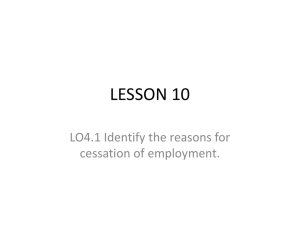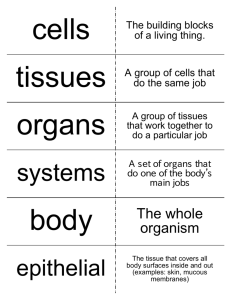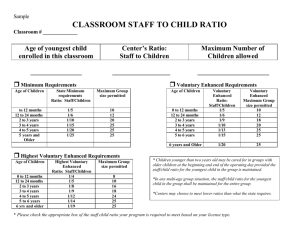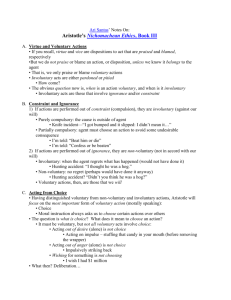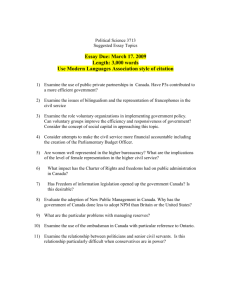Welfare Effects of Mechanisms for Procuring Global Public Goods Daniel Altman
advertisement
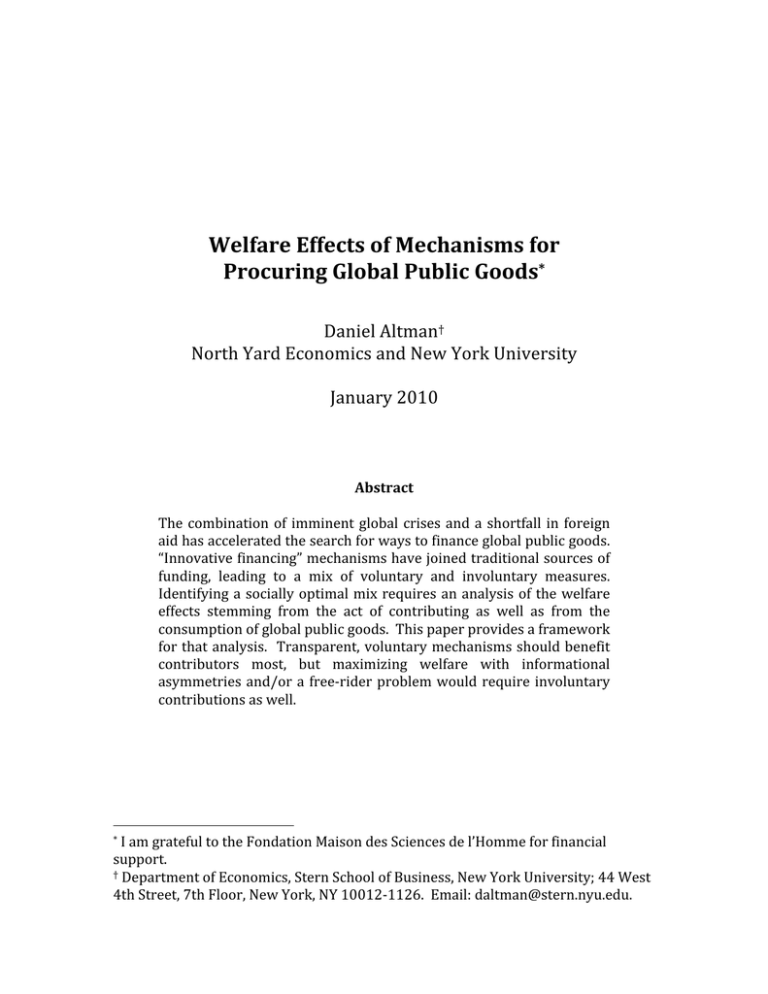
Welfare Effects of Mechanisms for Procuring Global Public Goods* Daniel Altman† North Yard Economics and New York University January 2010 Abstract The combination of imminent global crises and a shortfall in foreign aid has accelerated the search for ways to finance global public goods. “Innovative financing” mechanisms have joined traditional sources of funding, leading to a mix of voluntary and involuntary measures. Identifying a socially optimal mix requires an analysis of the welfare effects stemming from the act of contributing as well as from the consumption of global public goods. This paper provides a framework for that analysis. Transparent, voluntary mechanisms should benefit contributors most, but maximizing welfare with informational asymmetries and/or a free‐rider problem would require involuntary contributions as well. * I am grateful to the Fondation Maison des Sciences de l’Homme for financial support. † Department of Economics, Stern School of Business, New York University; 44 West 4th Street, 7th Floor, New York, NY 10012‐1126. Email: daltman@stern.nyu.edu. 1. Introduction The first decade of the new millennium has seen an unprecedented effort by the governments of the world to confront global problems with shared consequences. The pursuit of peace, clean air, disease‐free populations and other global public goods has taken on a special urgency thanks to the integration of the world economy and the realization that crises in these areas could be imminent. Because of a lack of coordination, these goods are almost certainly underprovided from a standpoint of social welfare. Some progress has already been made in developing ways of financing these goods, but an analysis of welfare effects on contributors reveals that a more economically attuned strategy could help to bring the provision of global public goods closer to optimal levels.* Global public goods benefit everyone on the planet, no matter how many people enjoy them, and yet no individual, business, or government typically has enough of an incentive to provide them unilaterally. There is a clear need for coordination, but that, too, is difficult. In theory, any entity participating in a group whose goal was to purchase a global public good would have an incentive to renege on its contribution and free‐ride on those of the other members. In reality, there are even more challenges. For example, many wealthy countries send aid to the same poor countries to achieve the same goals, such as fighting poverty or disease, but their generosity is often idiosyncratic, politically driven, and unrelated to the actions of other donors. Against this backdrop, Binger [2003] offers a useful catalog of possible pathways for the financing of global public goods, ranging from traditional means such as debt relief and foreign aid to more innovative mechanisms such as a currency transaction tax and capped emissions trading. In part because pools of official funds and private charitable donations have been insufficient to provide many global public goods, the attention of governments and aid professionals has shifted to these “innovative financing” mechanisms as a solution (see, for an early example, Desai et al. [2002]). And indeed, in the years since Binger’s cataloguing exercise, several of these mechanisms have begun operating, most with the goal of eradicating deadly epidemics in the developing world. All financing for global public goods must eventually come from individuals, however, whether or not their governments and other entities act as intermediaries. Coordinating individuals rather than governments seems like an even more difficult task because of their sheer numbers. But despite this apparent difficulty, some of the new mechanisms have arisen to target individuals directly and en masse. * Throughout this paper, I am finessing the question of whether choosing a more socially efficient mechanism to finance a global public good might actually raise the socially optimal level of provision of that good. For simplicity, we may assume that the financing is being raised from a negligible group of people compared to the group of people who benefit from the global public good. 2 Evaluations of the mechanisms’ progress to date has been fairly positive, but mainly because the mechanisms have succeeded in raising a lot of money in a short period of time [Levine and Pickett, 2007]. Some researchers, such as Severino and Ray [2009], have argued for measures of success that focus more on outcomes than on mere amounts of money committed; these outcomes would, presumably, include the provision of global public goods. But to understand the full effects on social welfare caused by these mechanisms, it is important to consider not just the recipients but also the contributors of aid. 2. Social welfare analysis The amount of net social benefit created by the innovative financing mechanisms – or, for that matter, any aid mechanism – depends not just on how the money is used but also on how and from whom it is collected. Each individual who contributes to a global public good receives some net benefit that can be stated in terms of utility. This marginal benefit, which could be positive or negative, is a combination of 1) the good or bad feeling the individual experiences as a result of making the contribution, 2) the material benefit from the global public good being purchased, and 3) the material cost of making the contribution in terms of foregone alternatives. The exact amount of the net benefit will depend in large part on the individual’s preferences, endowment, outside options, and ex ante level of utility. Because contributions to global public goods are not always voluntary – sometimes they are collected as taxes, for example – the individual may not always experience a good feeling from contributing; studies such as the World Values Survey have suggested that preferences for aid to foreign countries can vary widely: Table 1: Residents’ attitudes to foreign aid provided by their governments Country USA Japan Sweden Thailand Response to “Amount of foreign aid”: Too low 28% 23% 48% 24% About right 52% 53% 48% 61% Too high 20% 24% 4% 15% N = 1191 707 959 1526 Source: World Values Survey 2005‐2008, online database (excerpt only) 3 On its face, this argument – that an individual may experience a bad feeling upon contributing to a global public good – suggests that the individual correctly perceives the use of his or her involuntary contribution and does not agree with it. But the presence of an informational asymmetry could also reduce the good feeling a contributor receives; individuals might not understand how their contributions are being used, and, as a result of this confusion, they might not have a favorable attitude towards making those contributions. If an individual does not experience any good feeling from contributing, the only benefit will be from the global public good itself, which, by definition, benefits everyone on the planet. The amount of this benefit, however, can be very heterogeneous. It may depend on several factors beyond simple preferences: 1. Geographic location (for example, residents of Tuvalu whose homes will be destroyed by rising sea levels resulting from global warming may care much more about reducing emissions than people in Minnesota). 2. Lifestyle (someone who travels overseas for work may care much more about reduction in global conflict than someone who doesn’t). 3. Age (a younger person stands to benefit much more from the provision of a global public good – if it is durable, like the eradication of a disease – than an older person with similar preferences). This analysis holds whether the individual’s contribution is made directly (e.g., buying solar panels in order to stop using energy extracted from fossil fuels) or indirectly (e.g., paying to build a bridge in a poor country through tax revenue that is used to finance official aid). But clearly, the exact mechanism used to collect the contributions can have a profound effect on the net benefit to the contributors. A voluntary contribution should always have a positive net benefit, since the individual freely chooses to make it. An involuntary contribution collected as a tax may or may not have a positive net benefit, depending on the individual’s preferences. If an informational asymmetry is present, some individuals may receive negative net benefit from involuntary mechanisms like taxes even if they do receive some benefit from the global public good being procured. Based on these preliminary observations, we can begin to rate several existing mechanisms – innovative financing and others – designed to contribute to global public goods. Voluntary mechanisms should always provide positive net benefit to contributors. Involuntary mechanisms may or may not do so. In both cases, informational asymmetries could further reduce the potential benefit received from good feelings about the contribution. Table 2 lists some aid programs that typify different types of mechanisms, with those more likely to give positive net benefit to contributors (holding the benefit from global public goods and the material cost of contributing constant) nearer to the top: 4 Table 2: Mechanisms for procuring global public goods (not an exhaustive list) Mechanism Voluntary/ Asymmetry on Asymmetry on name involuntary contribution size contribution use MassiveGood voluntary none exact community (non‐profit) being helped will soon be identified Kiva voluntary none loans are bundled (non‐profit) so exact recipients are unknown Organic Meltdown voluntary amount of money website shows (private) used to save trees approximate is unknown location of trees being saved Product (Red) voluntary amount donated the general cause (private) for each purchase being helped is is unknown known UNITAID involuntary sizes of taxes the general cause (government are public being helped is multilateral) known IFFIm involuntary money comes the general cause (government from general being helped is multilateral) tax revenue known AMC involuntary money comes the general cause (government from general being helped is multilateral) tax revenue known IFIs involuntary money comes information can be (government from general obtained from multilateral) tax revenue annual reports Foreign aid involuntary money comes some information (government) from general can be obtained tax revenue from legal records Backers of programs are in parentheses. See Appendix A for descriptions of mechanisms. 5 3. Policy implications 3.1 Political attractiveness of voluntary and involuntary mechanisms Again holding the benefit from the global public goods and the material cost of contributing constant, the rough ranking in Table 2 is likely to correspond to the political attractiveness of the different options. Voters will probably support the options that seem to offer them the highest net benefit. Yet these options may not actually maximize welfare. If there is an asymmetry of information about benefit of the global public good, then involuntary mechanisms might be needed to reach a social welfare maximum. For example, an individual may think that the benefit attached to stopping climate change is zero. This individual probably would not make a voluntary contribution to a program that sought to reduce harmful emissions, nor would the individual be likely to support the idea of collecting contributions through a tax. Yet if the benefit from stopping climate change were in fact positive, those decisions not to contribute would fail to maximize the individual’s welfare. If the informational asymmetry were eliminated, it would be easier to replace the tax with a voluntary mechanism; individuals’ own decisions would bring the level of the global public good closer to the social optimum. Even without informational asymmetries, the free‐rider problem (as outlined above) could be an obstacle to achieving a social welfare optimum with voluntary mechanisms alone. But, since involuntary mechanisms may reduce welfare for some individuals, a combination of voluntary and involuntary mechanisms would likely be needed to reach an optimum. For example, an involuntary mechanism might be used to finance 80 percent of the socially optimal level of a global public good, and individuals who received a positive net benefit from voluntary contributions might make up the other 20 percent. The survey data cited earlier suggest that this outcome would be superior to financing 100 percent of the global public good with involuntary contributions. 3.2 Evaluation of new mechanisms Several new mechanisms for financing global public goods are currently being considered by governments and multinational organizations. Foremost among these is a tax on financial transactions, specifically currency trades, which was one of the first proposals for an innovative financing mechanism [Landau et al., 2004]. The welfare effects of this tax for contributors are difficult to predict, for several reasons: 1) people who pay the tax may not know they are paying it, e.g. in small transactions done by tourists; 2) it is not clear who actually bears the economic burden of the tax – most of its revenue would be collected from businesses, so shareholders, employees, and customers could share the burden; 3) the revenue from the tax may be split between several causes, so contributors would not know with certainty how their money was being used. In addition, as an involuntary 6 mechanism, the tax risks making those who would prefer not to contribute worse off. Another new initiative is Debt2Health, a partnership between the Global Fund to Fight AIDS, Tuberculosis and Malaria and a consortium of governments led by Germany. Participating countries can have portions of their sovereign debt forgiven by creditor nations in exchange for a promise to invest in health‐promoting programs through the Global Fund. This is also an involuntary mechanism, because debts owed to taxpayers are being swapped at the behest of their governments. It is also difficult for taxpayers to calculate exactly how much they are contributing at an individual level. A third initiative commonly mooted is that of a global lottery in which the revenue from ticket sales would be split between prizes, administrative costs, and the purchase of global public goods. Typically, as much as one‐third of the revenue collected for a given drawing can be diverted from prize money without overly diminishing the appetite of buyers for tickets [Quint, 2009]. The lottery would clearly be voluntary, so – putting aside for the moment the possibility that ticket buyers have dynamically inconsistent preferences – it is fair to assume that contributors would receive a positive net benefit from participating. It would be easy enough to inform the participants of the share of each ticket’s price that went to purchasing global public goods; indeed, this might be a selling point. Moreover, there would be ample opportunity to make the uses of the lottery money transparent, perhaps even by offering separate games to finance different global public goods. 3.3 Transparency The clearest policy implication from this analysis is that in the case of every mechanism for financing the purchase of global public goods, either voluntary or involuntary, improving transparency may be able to increase the benefit to individuals. Moreover, improving transparency should also increase the willingness of individuals to contribute to the purchase of global public goods; they will know exactly how they will be helped by the purchase, and they can make a decision with full knowledge of the size of their contribution and how it would be used. Recent evidence [Tingley, 2009] suggesting a strong relationship between beliefs about the effects of foreign aid and preferences for foreign aid bolsters this point. It will be easier to achieve the socially optimal levels of global public goods, therefore, by using fundraising mechanisms that are both voluntary and transparent, like MassiveGood and Organic Meltdown. These two mechanisms exist in the private sector, but others could exist in the public sector as well. For example, American taxpayers are offered a check‐box on their annual tax returns to contribute to a federal poor that finances political campaigns. 7 In the case of existing mechanisms, the priority should be to eliminate informational asymmetries whenever possible by informing the public about the sizes, uses, and results of their contributions. Doing so could make political approval of more socially optimal levels of global public goods easier. A model in this respect is UNITAID, which places advertisements and make documents available to the public to explain the size of their contributions and how they are used. In addition to raising the potential welfare benefits of contributing to global goods, removing informational asymmetries could also change the political landscape for their procurement. Generally speaking, young people and countries with younger populations would be expected to favor contributions more, holding opportunity costs of contributing constant, as would countries where the instantaneous benefit of global public goods is higher – for example, an island nation like Tuvalu facing submersion as a result of climate change. Moreover, as stated earlier, removing informational asymmetries could also allow some involuntary mechanisms to be replaced with voluntary mechanisms, potentially leading to a substantial increase in social welfare. This could be particularly important for reaching a social welfare optimum, given recent evidence that public monies used to buy global public goods may crowd out private contributions [Okten and Osili, 2009] and that individuals’ views about their own countries’ governments may affect their attitudes towards foreign aid [Chong and Gradstein, 2008]. Thus, a transparent combination of voluntary – where and when they are possible – and involuntary mechanisms seems most likely to achieve a social welfare optimum and an optimal level of global public goods. 8 APPENDIX A Descriptions of mechanisms for procuring global public goods AMC (Advanced Market Commitment) – a government‐led consortium that guarantees large orders of medical treatments to assure production and maintain low prices; the funds used come from the governments’ general revenue. IFFIm (International Finance Facility for Immunization) – a government‐led consortium through which several countries back bonds issued to raise money for the purchase of vaccines; the funds used come from the governments’ general revenue. IFIs (International Financial Institutions) – organizations, most notably the International Monetary Fund and World Bank, that pool donations or loans from the governments of many nations to offer direct aid and financial assistance to developing countries. Kiva – a website that solicits small zero‐interest loans from the public to give liquidity to families and entrepreneurs in poor countries; the loans are bundled so that the donors do not always know whom they are helping. MassiveGood – a program of the Millennium Foundation that collects small donations from customers of travel booking websites; the exact amounts contributed go to fighting epidemics, and contributors will soon be able to track the treatments paid for by their donations using satellite technology. Organic Meltdown – a chocolate brand where every bar’s wrapper contains a code which, if entered on the brand’s website, will trigger a donation that saves a tree in South America; the location of the tree is shown on a Google satellite map. Product (Red) – a consortium of companies that contribute a percentage of profits from specially branded products sold directly to consumers to the fight against epidemics; the exact amounts of money contributed are unknown to consumers UNITAID – an agency affiliated with the World Health Organization that collects small taxes on airline tickets instituted by countries around the world; information about the amounts of the individual taxes and how the revenue is used (fighting epidemics) is publicly available and spread through UNITAID’s own publicity. 9 REFERENCES Binger, A. [2003], “Global public goods and potential mechanisms for financing availability,” background paper prepared for the Fifth Session of the Committee for Development Policy meeting (April 7‐11) Chong, A. and Gradstein, M. [2008], “What determines foreign aid? The donors' perspective,” Journal of Development Economics, Vol. 81, No. 1 (August) Desai, N. et al. [2002], Capacity­building in Africa: Effective aid and human capital (New York: United Nations) Landau, J‐P. et al. [2004], “Report to Mr. Jacques Chirac, President of the Republic,” mimeo (Working Group on New International Financial Contributions, December) Levine, R. and Pickett, J. [2007], “Creative Accounting: Donor Perspectives on Innovative Financing in Health,” Global Health Policy (Center for Global Development blog, October 23) Okten, C. and Osili, U. [2009], “Preferences for International Redistribution,” mimeo, Indiana University‐Purdue University at Indianapolis (September) Quint, M. [2009], “New York Lottery Shuns Treasuries in Bid for Riskier Investment,” Bloomberg News (February 10) Severino, J‐M. and Ray, O. [2009], “The End of ODA: Death and Rebirth of a Global Public Policy,” Center for Global Development Working Paper Series (No 167, March) Smith, T. [2009], “Trends in National Spending Priorities, 1973‐2008,” mimeo, National Opinion Research Center, University of Chicago (February 10) Tingley, D. [2009], “Beliefs and Preferences Over Foreign Economic Aid: An Experimental Study” mimeo, Princeton University (November 7) 10
